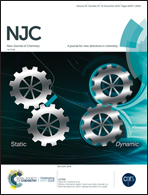Hydrothermal fabrication of hierarchical CuO nanoflowers for dual-function amperometric sensing of hydrogen peroxide and glucose†
Abstract
In this paper, hierarchical CuO nanoflowers were prepared by a facile, controllable and low-cost method. The structure and morphology of the CuO nanoflowers were characterized by scanning electron microscopy, X-ray diffraction spectroscopy, nitrogen adsorption–desorption isotherm and X-ray photoelectron spectroscopy measurements. CuO nanoflowers were then immobilized on the surface of a glassy carbon electrode to develop a nonenzymatic sensor for simultaneous detection of hydrogen peroxide and glucose. Electrochemical measurements demonstrated that the sensor showed good response toward H2O2 with a high sensitivity of 956.69 μA mM−1 cm−2 and a wide linear range of 0.005–14.07 mM. Moreover, the nonenzymatic sensor also exhibited excellent electrocatalytic activity toward glucose oxidation with a high sensitivity of 1086.34 μA mM−1 cm−2 and a low detection limit of 0.12 μM (S/N = 3). This study paves a new way for the construction of nonenzymatic sensors.



 Please wait while we load your content...
Please wait while we load your content...